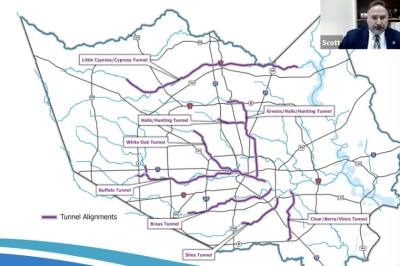Funded by a $2.5 million grant from the U.S. Department of Housing and Urban Development, Phase 2 of the district’s feasibility study identified eight tunnel alignments that would mostly follow existing channels.
HCFCD officials presented Phase 2 of the study at a virtual community engagement meeting June 16.
The study determined that 11 of the county’s 23 major watersheds would receive the greatest benefit from a tunnel system, taking into account factors such as population density and concentrated areas known as “damage centers” where homes and businesses repeatedly flood.
The next phase of the study is set to begin in early 2023 and could last about three years, according to Scott Elmer, assistant director of operations for HCFCD. Phase 3 is backed by $20 million in bond funding from HCFCD's $2.5 billion bond approved by voters in 2018, and it will focus on tightening up the engineering details and investigating sources of funding for the project.
“We will leave no stone unturned when it comes to funding,” Elmer said. “We’ll investigate funding at all levels. I’m not going to be able to say today whether this is something [the Federal Emergency Management Agency would] say is right up [its] alley, but it’s something we’re looking at in Phase 3.”
With the size and scale of the tunnel system, county funding would likely be needed to supplement state and federal funding.
Upside of underground tunnels
According to Elmer, one big advantage of a tunnel system is the reduced land acquisition when compared to traditional methods of flood management, such as stormwater basins or buyouts. In one unspecified tunnel alignment, Elmer said 27 acres of land would be needed for a tunnel—over 90 times less than the 2,483 acres of land needed to build traditional stormwater infrastructure.
Running 100 feet underground, the 35- to 40-foot diameter concrete tunnels would be built under existing channels and use public rights of way as much as possible, according to Elmer.
He added that over a service life of 100 years, 80,000-120,000 cumulative instances of flooding could be avoided. This number includes structures that flood infrequently to ones located in low-performing watersheds with more frequent flooding.
The public comment period before Phase 3 closes on Sept. 30. The flood control district posts updates on its website.






